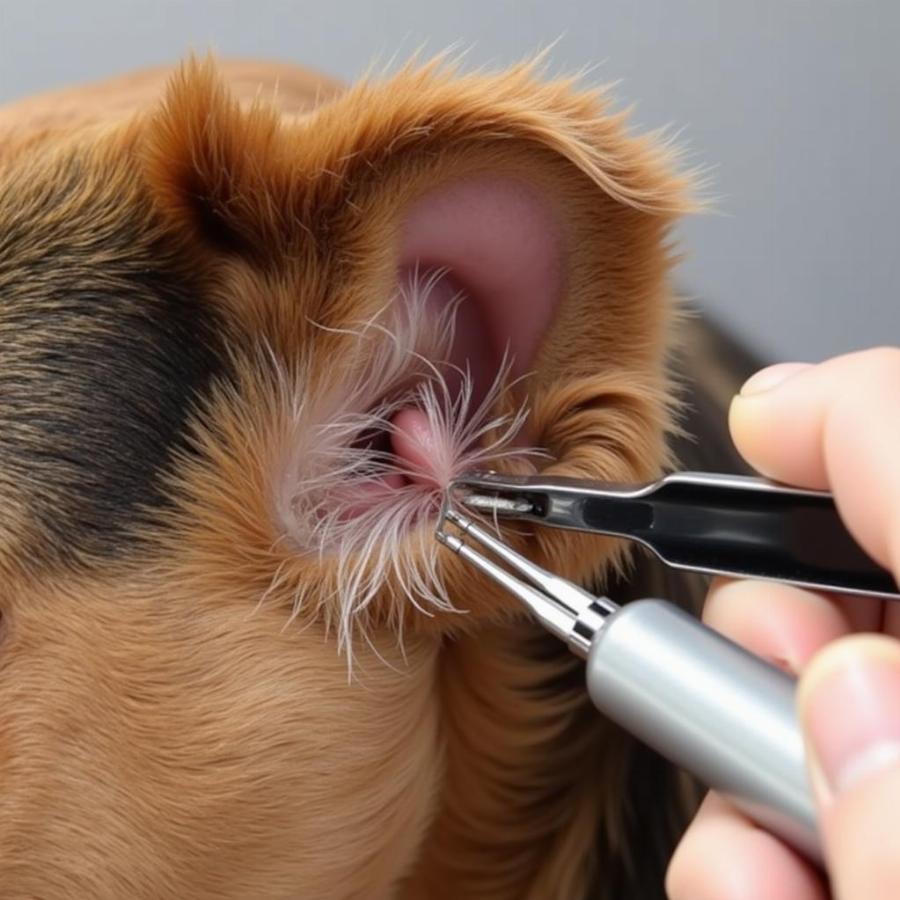Dog ear hair removal is a common grooming practice for certain breeds. While some owners prefer the natural look, others opt for hair removal for hygienic or aesthetic reasons. Choosing the right dog ear hair removal tool can make the process safer and more comfortable for your furry friend. This guide will delve into the various aspects of dog ear hair removal, from understanding the reasons behind it to selecting the best tools and techniques.
Why Remove Dog Ear Hair?
Some breeds are prone to excessive hair growth within the ear canal, which can trap moisture and debris, creating a breeding ground for bacteria and yeast. This can lead to ear infections, characterized by symptoms like head shaking, scratching, and unpleasant odor.  Dụng cụ nhổ lông tai chó Regular dog ear hair removal can help prevent these infections by promoting better air circulation and cleanliness. Beyond hygiene, some owners prefer removing ear hair for aesthetic reasons, especially in show dogs.
Dụng cụ nhổ lông tai chó Regular dog ear hair removal can help prevent these infections by promoting better air circulation and cleanliness. Beyond hygiene, some owners prefer removing ear hair for aesthetic reasons, especially in show dogs.
Choosing the Right Dog Ear Hair Removal Tool
The market offers various dog ear hair removal tools, each with its pros and cons. Finding the right one depends on your dog’s breed, the amount of hair, and your comfort level.
Tweezers and Forceps
Tweezers are a common and relatively inexpensive tool. They’re effective for plucking individual hairs, especially those protruding from the ear canal. Forceps, with their wider grip, can remove multiple hairs at once. However, both require caution to avoid pulling too hard and causing discomfort or injury.
Ear Powder
Ear powder is designed to grip the hair, making it easier to remove with tweezers or forceps. It also helps reduce slippage and minimize discomfort for the dog. how to take mats out of dog hair
Hemostats
Hemostats, originally designed for surgical procedures, are also used for dog ear hair removal. Their locking mechanism provides a secure grip, allowing for precise and controlled hair removal. However, they require some practice to master and should be used with care.
Electric Ear Hair Trimmers
Electric trimmers offer a quicker and less tedious way to remove ear hair. They’re particularly useful for dogs with dense ear hair. However, the noise and vibration can be unsettling for some dogs, and there’s a slight risk of nicking the ear canal if not used carefully.
How to Remove Dog Ear Hair Safely
Regardless of the chosen tool, always prioritize your dog’s comfort and safety.
- Consult your veterinarian: Before attempting ear hair removal, especially for the first time, consult your vet. They can advise on the best method and identify any underlying ear conditions.
- Restrain your dog gently: Have someone assist you in holding your dog securely but comfortably. This prevents sudden movements that could lead to injury.
- Use proper lighting: Adequate lighting is crucial to see the hairs clearly and avoid accidental injury.
- Be gentle and patient: Avoid pulling hairs too quickly or forcefully. Take breaks if your dog becomes stressed or uncomfortable.
- Clean the ears afterward: Use a vet-approved ear cleaner to remove any remaining debris and soothe the ear canal.
Does Removing Dog Ear Hair Hurt?
While some discomfort is unavoidable, the process shouldn’t be painful. Using the right technique and taking breaks can minimize any discomfort. If your dog exhibits signs of pain, stop immediately and consult your vet. whitening shampoo for dogs
Expert Insights
Dr. Emily Carter, DVM, advises, “Regular ear cleaning and hair removal are essential for breeds prone to ear infections. It’s always best to consult your vet for personalized guidance.”
Sarah Miller, Certified Dog Groomer, recommends, “Using ear powder can significantly improve grip and make the hair removal process smoother for both you and your dog.”
Conclusion
Choosing the right dog ear hair removal tool and employing proper techniques are crucial for maintaining your dog’s ear health and hygiene. pictures of histiocytoma in dogs Always prioritize your dog’s comfort and safety, and consult your vet if you have any concerns.
FAQ
- How often should I remove my dog’s ear hair? This depends on the breed and hair growth rate. Consult your vet for a personalized recommendation.
- Can I use human ear hair removal tools on my dog? It’s best to use tools specifically designed for dogs.
- What are the signs of an ear infection? Head shaking, scratching, redness, swelling, and foul odor are common signs.
- Is it necessary to remove all the ear hair? Removing hair that obstructs the ear canal is usually sufficient.
- What if my dog resists ear hair removal? Try making the experience positive with treats and praise. If the resistance persists, consult a professional groomer.
- Can ear hair removal prevent all ear infections? While it significantly reduces the risk, other factors can also contribute to ear infections.
- Are there any breeds that don’t require ear hair removal? Breeds with less ear hair may not require regular removal.